An Empirical Study of a Passive Exterior Window for an Office Building in the Context of Ultra-Low Energy
Abstract
:1. Introduction
2. Literature Review
2.1. Energy Efficiency of External Windows
2.2. Passive Exterior Windows
2.3. The Importance of Exterior Windows for Interior Comfort
3. Materials and Methods
3.1. Experimental Principal Model
3.2. Experimental Platform and Testing Instructions
3.3. Test Scenarios and Outdoor Climate Conditions
4. Analysis of Text and Regression Results
4.1. Analysis of Indoor Environmental Testing Results
4.1.1. Summer Scenarios
4.1.2. Winter Scenarios
4.2. AT Calculation and Evaluation Analysis
4.2.1. AT Calculation Method
4.2.2. AT Analysis
4.2.3. AT Evaluation
4.3. Non-Linear Fitting Regression Analysis
4.3.1. IET Non-Linear Fitting Regression
4.3.2. WST Non-Linear Fitting Regression
4.3.3. AT Non-Linear Fitting Regression
5. Discussion
5.1. Impact of Different Elements
5.2. Comparison of Related Studies
6. Conclusions
- Regarding the IET, in summer, the PR exhibited a significantly lower temperature than the NPR, achieving a peak reduction of 1.2 °C and an average indoor temperature reduction of 0.8 °C. Additionally, the maximum indoor wind speed reached 2.8 m/s during the same period. In winter, the average indoor temperature in NPR was 0.1–1.8 °C higher than that in PR. However, the maximum temperature difference was 8.1 °C in NPR, whereas it was 6.8 °C in PR. It is evident that the passive exterior window could effectively suppress the increase of indoor temperature in summer by facilitating heat dissipation through the exterior window, resulting in a cooling effect. Moreover, it exhibited a stabilizing effect on the interior room temperature during winter;
- Regarding the WST, in summer, the PR exhibited a maximum reduction of 0.6 °C in WST under ventilated conditions and a 0.2 °C reduction under unventilated conditions. Meanwhile, wall surface temperatures in the room also experienced partial reductions. During winter, the mean value of the WST in the NPR was slightly higher (by 0.1 °C) compared to the PR. The temperature difference between the WST of the PR was 7.7 °C, while it was 9.3 °C for the NPR. Additionally, other wall surface temperatures of the passive room were higher by 0.1–1.0 °C compared to those of the NPR. It is evident that the passive exterior window provided a certain level of thermal resistance to the WST and the interior wall surface temperature, effectively ensuring the stability of the interior temperature;
- The results of the AT calculation and fitting revealed the following. During summer, the AT in the PR could be reduced by up to 3.5 °C when the window was opened for ventilation, with the human thermal perception primarily described as “slightly warm”. In the scenario in which the window remained closed, the AT could still be reduced by 0.9 °C, but the human heat sensation was described as “hot”. During winter, the AT in the PR was lower than in the NPR, but the time for human thermal perception to reach comfort was extended by 0.5 h. The analysis indicated that the impact of passive exterior windows on the AT was more pronounced in summer compared to winter. Nonetheless, in terms of stability, the AT of PR showcased a superior performance to that of NPR only in non-ventilated conditions during summer. However, the desired level of stability in the AT was not consistently achieved in other scenarios.
Author Contributions
Funding
Institutional Review Board Statement
Informed Consent Statement
Data Availability Statement
Acknowledgments
Conflicts of Interest
References
- Sebastian, C. Peter Reduction of CO2 to Chemicals and Fuels: A Solution to Global Warming and Energy Crisis. ACS Energy Lett. 2018, 3, 1557–1561. [Google Scholar] [CrossRef]
- Cdb, P. 2022 Global Status Report For Buildings And Construction. 2022. Available online: https://globalabc.org/our-work/tracking-progress-global-status-report (accessed on 1 June 2023).
- Xu, P.; Shen, Y.; Chen, L.; Mao, J.; Chang, E.; Ji, Y. Assessment of Energy-Saving Technologies Retrofitted to Existing Public Buildings in China. Energy Effic. 2016, 9, 67–94. [Google Scholar] [CrossRef]
- Li, D.; Li, L.; He, J. A Review of Renewable Energy Applications in Buildings in the Hot-Summer and Warm-Winter Region of China. Renew. Sustain. Energy Rev. 2016, 57, 327–336. [Google Scholar] [CrossRef]
- Zhao, X.; Gao, C.-P. Research on Energy-Saving Design Method of Green Building Based on BIM Technology. Sci. Program. 2022, 2022, 2108781. [Google Scholar] [CrossRef]
- Yuan, X.; Wang, X.; Zuo, J. Renewable Energy in Buildings in China—A Review. Renew. Sustain. Energy Rev. 2013, 24, 1–8. [Google Scholar] [CrossRef]
- Zhou, S.; Zhao, J. Optimum Combinations of Building Envelop Energy-Saving Technologies for Office Buildings in Different Climatic Regions of China. Energy Build. 2013, 57, 103–109. [Google Scholar] [CrossRef]
- Sakellaris, I.; Saraga, D.; Mandin, C.; Roda, C.; Fossati, S.; De Kluizenaar, Y.; Carrer, P.; Dimitroulopoulou, S.; Mihucz, V.; Szigeti, T.; et al. Perceived Indoor Environment and Occupants’ Comfort in European “Modern” Office Buildings: The OFFICAIR Study. Int. J. Environ. Res. Public Health 2016, 13, 444. [Google Scholar] [CrossRef]
- Banihashemi, S.; Golizadeh, H.; Reza Hosseini, M.; Shakouri, M. Climatic, Parametric and Non-Parametric Analysis of Energy Performance of Double-Glazed Windows in Different Climates. Int. J. Sustain. Built Environ. 2015, 4, 307–322. [Google Scholar] [CrossRef]
- He, G.; Shu, L.; Zhang, S. Double Skin Facades in the Hot Summer and Cold Winter Zone in China: Cavity Open or Closed? Build. Simul. 2011, 4, 283–291. [Google Scholar] [CrossRef]
- Wang, Y.; Chen, Y.; Zhou, J. Dynamic Modeling of the Ventilated Double Skin Façade in Hot Summer and Cold Winter Zone in China. Build. Environ. 2016, 106, 365–377. [Google Scholar] [CrossRef]
- Javad, K.; Navid, G. Thermal Comfort Investigation of Stratified Indoor Environment in Displacement Ventilation: Climate-Adaptive Building with Smart Windows. Sustain. Cities Soc. 2019, 46, 101354. [Google Scholar] [CrossRef]
- Bülow-Hübe, H. Energy Efficient Window Systems. Effects on Energy Use and Daylight in Buildings. 2001. Available online: https://www.ebd.lth.se/fileadmin/energi_byggnadsdesign/images/Publikationer/Rapport_TABK-01-1022_Helena.pdf (accessed on 1 June 2023).
- Haglund, K.L. Decision-Making Methodology & Selection Tools for High-Performance Window Systems in U.S. Climates. In Proceedings of the 2nd Building Enclosure Science & Technology Conference, Portland, OR, USA, 12–14 April 2010. [Google Scholar]
- Sun, C.; Giles, H.; Lian, Z. The Dynamic Impact of Window Characteristics on Shading Factor and Energy Consumption. Sol. Energy 2014, 102, 1–13. [Google Scholar] [CrossRef]
- Lee, J.W.; Jung, H.J.; Park, J.Y.; Lee, J.B.; Yoon, Y. Optimization of Building Window System in Asian Regions by Analyzing Solar Heat Gain and Daylighting Elements. Renew. Energy 2013, 50, 522–531. [Google Scholar] [CrossRef]
- Elghamry, R.; Hassan, H. Impact of Window Parameters on the Building Envelope on the Thermal Comfort, Energy Consumption and Cost and Environment. Int. J. Vent. 2020, 19, 233–259. [Google Scholar] [CrossRef]
- Kahsay, M.T.; Bitsuamlak, G.T.; Tariku, F. Thermal Zoning and Window Optimization Framework for High-Rise Buildings. Appl. Energy 2021, 292, 116894. [Google Scholar] [CrossRef]
- He, Q.; Ng, S.T.; Hossain, M.U.; Skitmore, M. Skitmore Energy-Efficient Window Retrofit for High-Rise Residential Buildings in Different Climatic Zones of China. Sustainability 2019, 11, 6473. [Google Scholar] [CrossRef]
- Peng, C.; Wang, L.; Zhang, X. DeST-Based Dynamic Simulation and Energy Efficiency Retrofit Analysis of Commercial Buildings in the Hot Summer/Cold Winter Zone of China: A Case in Nanjing. Energy Build. 2014, 78, 123–131. [Google Scholar] [CrossRef]
- Huang, J.; Lv, H.; Gao, T.; Feng, W.; Chen, Y.; Zhou, T. Thermal Properties Optimization of Envelope in Energy-Saving Renovation of Existing Public Buildings. Energy Build. 2014, 75, 504–510. [Google Scholar] [CrossRef]
- Sadineni, S.B.; Madala, S.; Boehm, R.F. Passive Building Energy Savings: A Review of Building Envelope Components. Renew. Sustain. Energy Rev. 2011, 15, 3617–3631. [Google Scholar] [CrossRef]
- Wang, S.; Liu, Y.; Cao, Q.; Li, H.; Yu, Y.; Yang, L. Applicability of Passive Design Strategies in China Promoted under Global Warming in Past Half Century. Build. Environ. 2021, 195, 107777. [Google Scholar] [CrossRef]
- Chen, Y.; Yang, J.; Berardi, U.; Cui, G.; Li, R.; Li, N. Assessments of Multiple Operation Strategies in a Passive Office Building in Cold Region of China. Energy Build. 2022, 254, 111561. [Google Scholar] [CrossRef]
- Gou, S.; Nik, V.M.; Scartezzini, J.-L.; Zhao, Q.; Li, Z. Passive Design Optimization of Newly-Built Residential Buildings in Shanghai for Improving Indoor Thermal Comfort While Reducing Building Energy Demand. Energy Build. 2018, 169, 484–506. [Google Scholar] [CrossRef]
- Gong, X.; Akashi, Y.; Sumiyoshi, D. Optimization of Passive Design Measures for Residential Buildings in Different Chinese Areas. Build. Environ. 2012, 58, 46–57. [Google Scholar] [CrossRef]
- Lin, K.; Chao, L.; Lee, H.H.; Xin, R.; Liu, S.; Ho, T.C.; Huang, B.; Yu, K.M.; Tso, C.Y. Potential Building Energy Savings by Passive Strategies Combining Daytime Radiative Coolers and Thermochromic Smart Windows. Case Stud. Therm. Eng. 2021, 28, 101517. [Google Scholar] [CrossRef]
- Wang, S.; Jiang, T.; Meng, Y.; Yang, R.; Tan, G.; Long, Y. Scalable Thermochromic Smart Windows with Passive Radiative Cooling Regulation. Science 2021, 374, 1501–1504. [Google Scholar] [CrossRef]
- Ko, W.H.; Schiavon, S.; Zhang, H.; Graham, L.T.; Brager, G.; Mauss, I.; Lin, Y.-W. The Impact of a View from a Window on Thermal Comfort, Emotion, and Cognitive Performance. Build. Environ. 2020, 175, 106779. [Google Scholar] [CrossRef]
- Yeom, S.; Kim, H.; Hong, T.; Park, H.S.; Lee, D.-E. An Integrated Psychological Score for Occupants Based on Their Perception and Emotional Response According to the Windows’ Outdoor View Size. Build. Environ. 2020, 180, 107019. [Google Scholar] [CrossRef]
- Wang, L.; Greenberg, S. Window Operation and Impacts on Building Energy Consumption. Energy Build. 2015, 92, 313–321. [Google Scholar] [CrossRef]
- Han, M.; May, R.; Zhang, X.; Wang, X.; Pan, S.; Da, Y.; Jin, Y. A Novel Reinforcement Learning Method for Improving Occupant Comfort via Window Opening and Closing. Sustain. Cities Soc. 2020, 61, 102247. [Google Scholar] [CrossRef]
- Porritt, S.M.; Cropper, P.C.; Shao, L.; Goodier, C.I. Ranking of Interventions to Reduce Dwelling Overheating during Heat Waves. Energy Build. 2012, 55, 16–27. [Google Scholar] [CrossRef]
- Lei, Z.; Liu, C.; Wang, L.; Li, N. Effect of Natural Ventilation on Indoor Air Quality and Thermal Comfort in Dormitory during Winter. Build. Environ. 2017, 125, 240–247. [Google Scholar] [CrossRef]
- Wu, J. Thermal Comfort and Occupant Behaviour in Office Buildings in South-East China. Ph.D. Thesis, University of Nottingham, Nottingham, UK, 2015. Available online: https://eprints.nottingham.ac.uk/id/eprint/29435 (accessed on 1 June 2023).
- Yao, M.; Zhao, B. Window Opening Behavior of Occupants in Residential Buildings in Beijing. Build. Environ. 2017, 124, 441–449. [Google Scholar] [CrossRef]
- Zhang, X.; Ning, Q.; Chen, Z. Multi-Objective Optimization Design of Energy Efficiency for Office Building Window Systems Based on Indoor Thermal Comfort. Sci. Technol. Built Environ. 2023, 29, 1–14. [Google Scholar] [CrossRef]
- Abdullah, H.K.; Alibaba, H.Z. Window Design of Naturally Ventilated Offices in the Mediterranean Climate in Terms of CO2 and Thermal Comfort Performance. Sustainability 2020, 12, 473. [Google Scholar] [CrossRef]
- Cheung, T.; Schiavon, S.; Parkinson, T.; Li, P.; Brager, G. Analysis of the Accuracy on PMV—PPD Model Using the ASHRAE Global Thermal Comfort Database II. Build. Environ. 2019, 153, 205–217. [Google Scholar] [CrossRef]
- Omidvar, A.; Kim, J. Modification of Sweat Evaporative Heat Loss in the PMV/PPD Model to Improve Thermal Comfort Prediction in Warm Climates. Build. Environ. 2020, 176, 106868. [Google Scholar] [CrossRef]
- Steadman, R.G. A Universal Scale of Apparent Temperature. J. Appl. Meteorol. Climatol. 1984, 23, 1674–1687. [Google Scholar] [CrossRef]
- Zhang, H. Breathing Purification Energy-Saving Window. CN205591771U, 21 September 2016. [Google Scholar]
- Miao, Y.; Ding, Y. Indoor Environmental Quality in Existing Public Buildings in China: Measurement Results and Retrofitting Priorities. Build. Environ. 2020, 185, 107216. [Google Scholar] [CrossRef]
- Chen, W.-J.; Qiu, J.; Yang, J. Apparent Temperature Modeling Based on Improved GEP Algorithm. Control Eng. China 2018, 25, 136–142. [Google Scholar] [CrossRef]
- Matzarakis, A.; Mayer, H.; Iziomon, M.G. Applications of a Universal Thermal Index: Physiological Equivalent Temperature. Int. J. Biometeorol. 1999, 43, 76–84. [Google Scholar] [CrossRef] [PubMed]
- Zhang, C.; Wang, J.; Xu, X.; Zou, F.; Yu, J. Modeling and Thermal Performance Evaluation of a Switchable Triple Glazing Exhaust Air Window. Appl. Therm. Eng. 2016, 92, 8–17. [Google Scholar] [CrossRef]
- Hassouneh, K.; Alshboul, A.; Al-Salaymeh, A. Influence of Windows on the Energy Balance of Apartment Buildings in Amman. Energy Convers. Manag. 2010, 51, 1583–1591. [Google Scholar] [CrossRef]

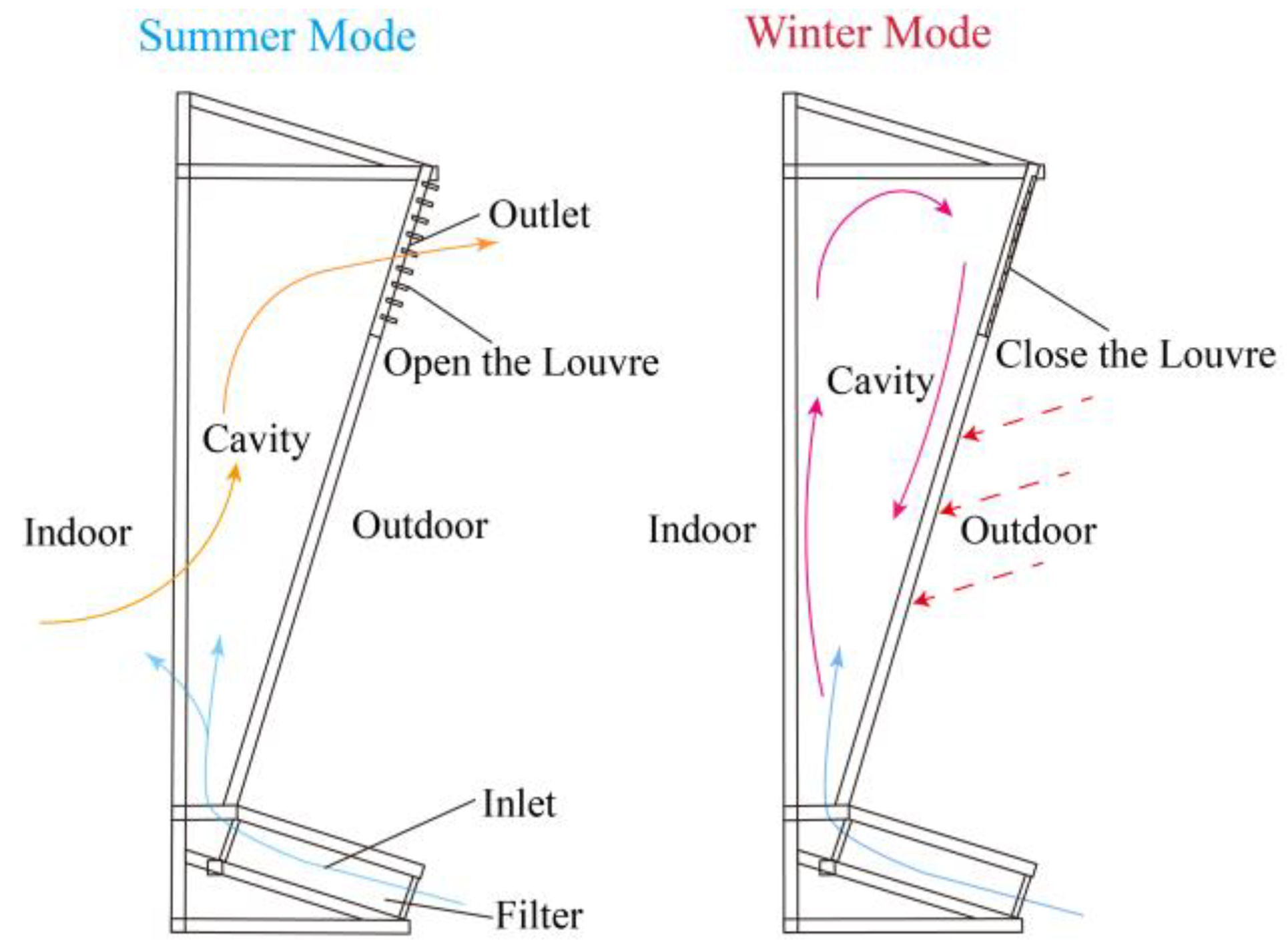
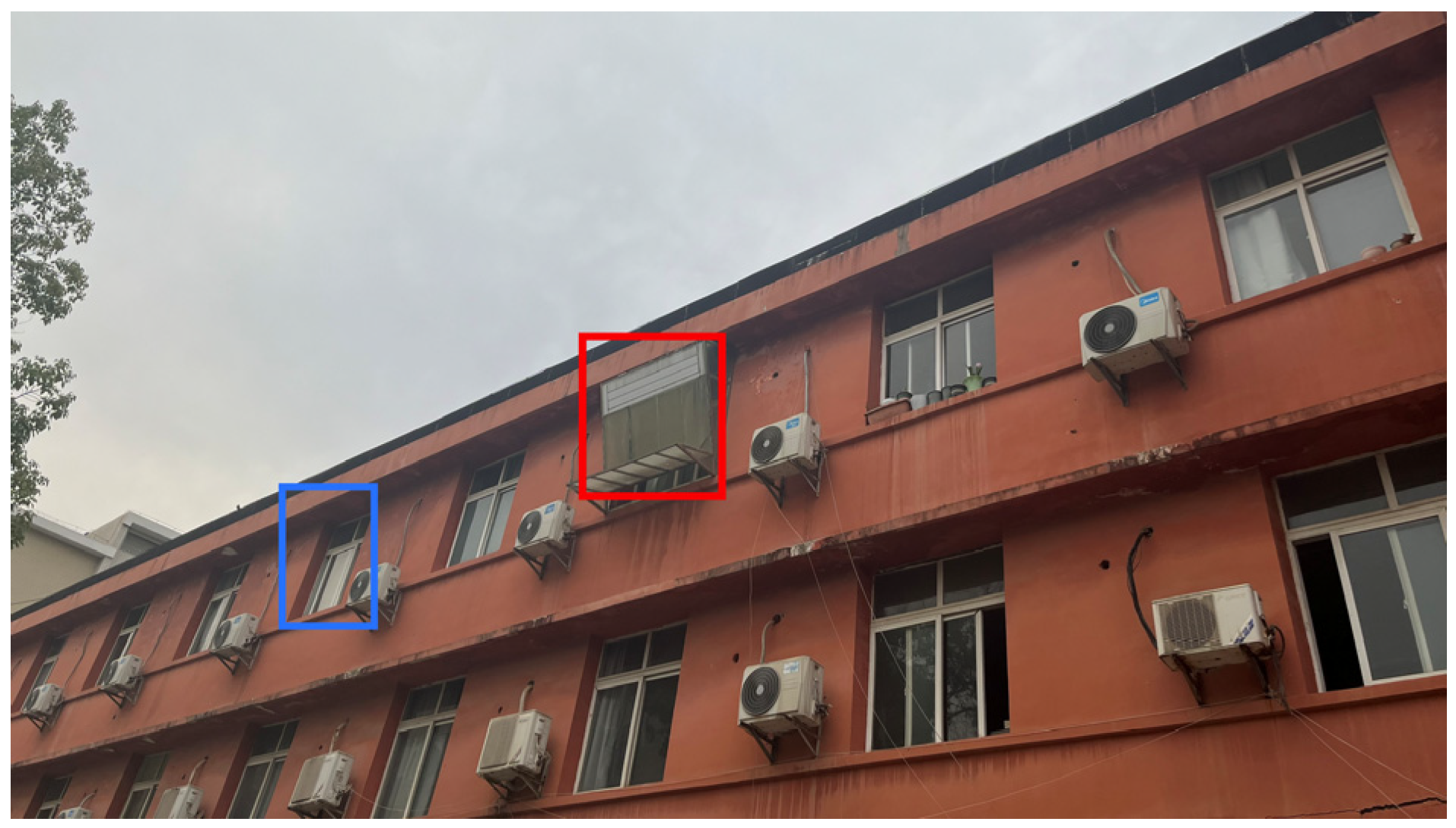




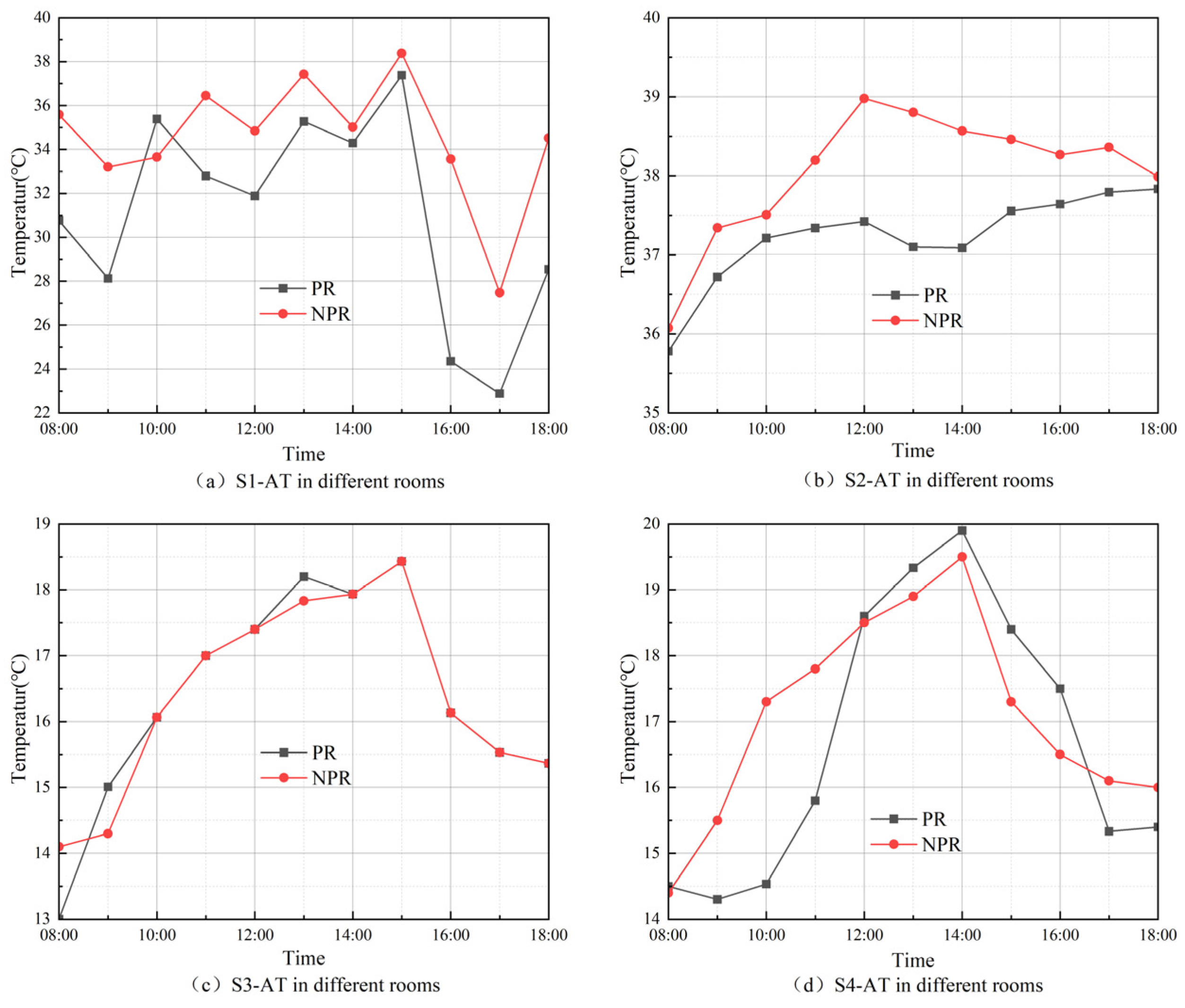

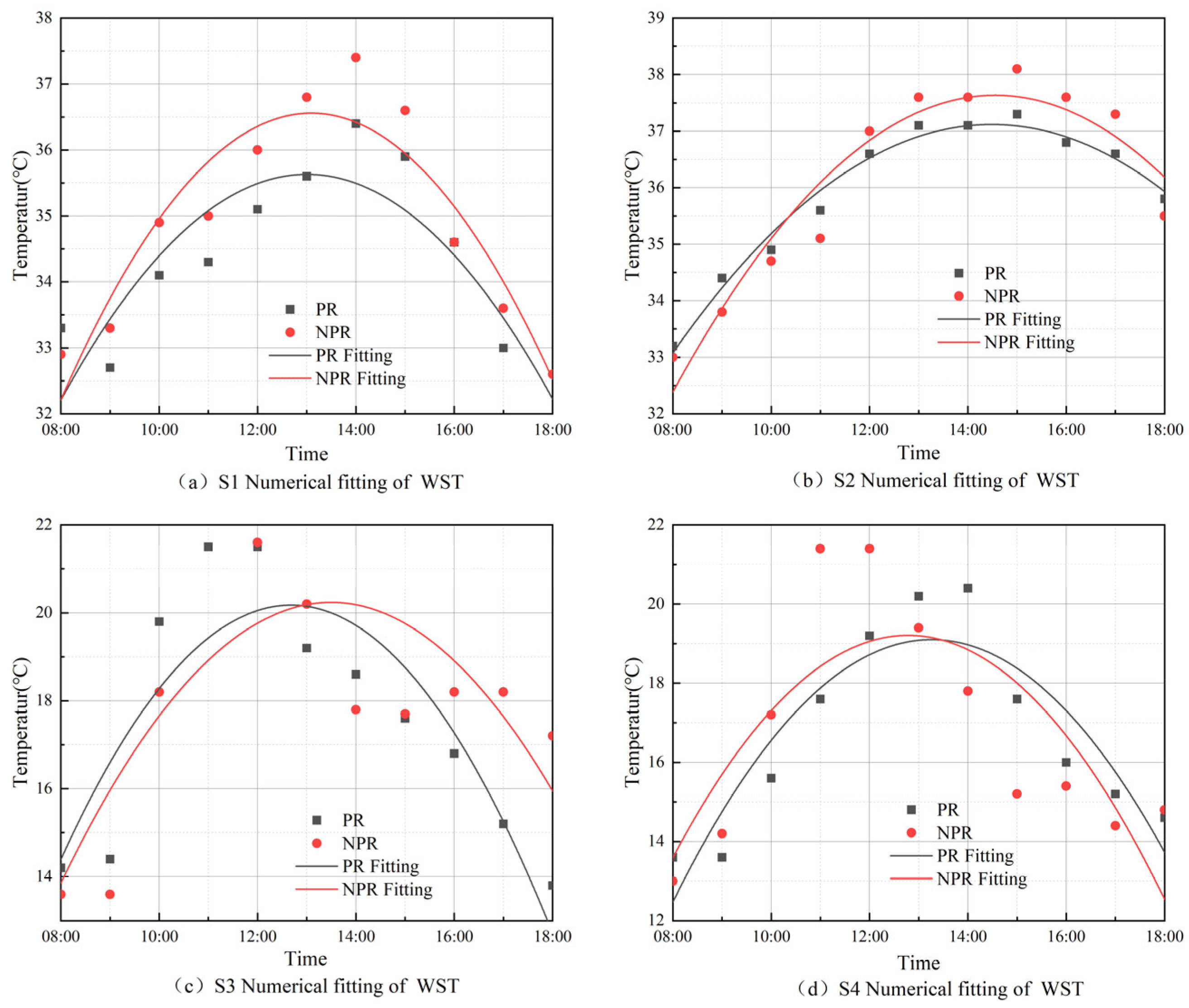
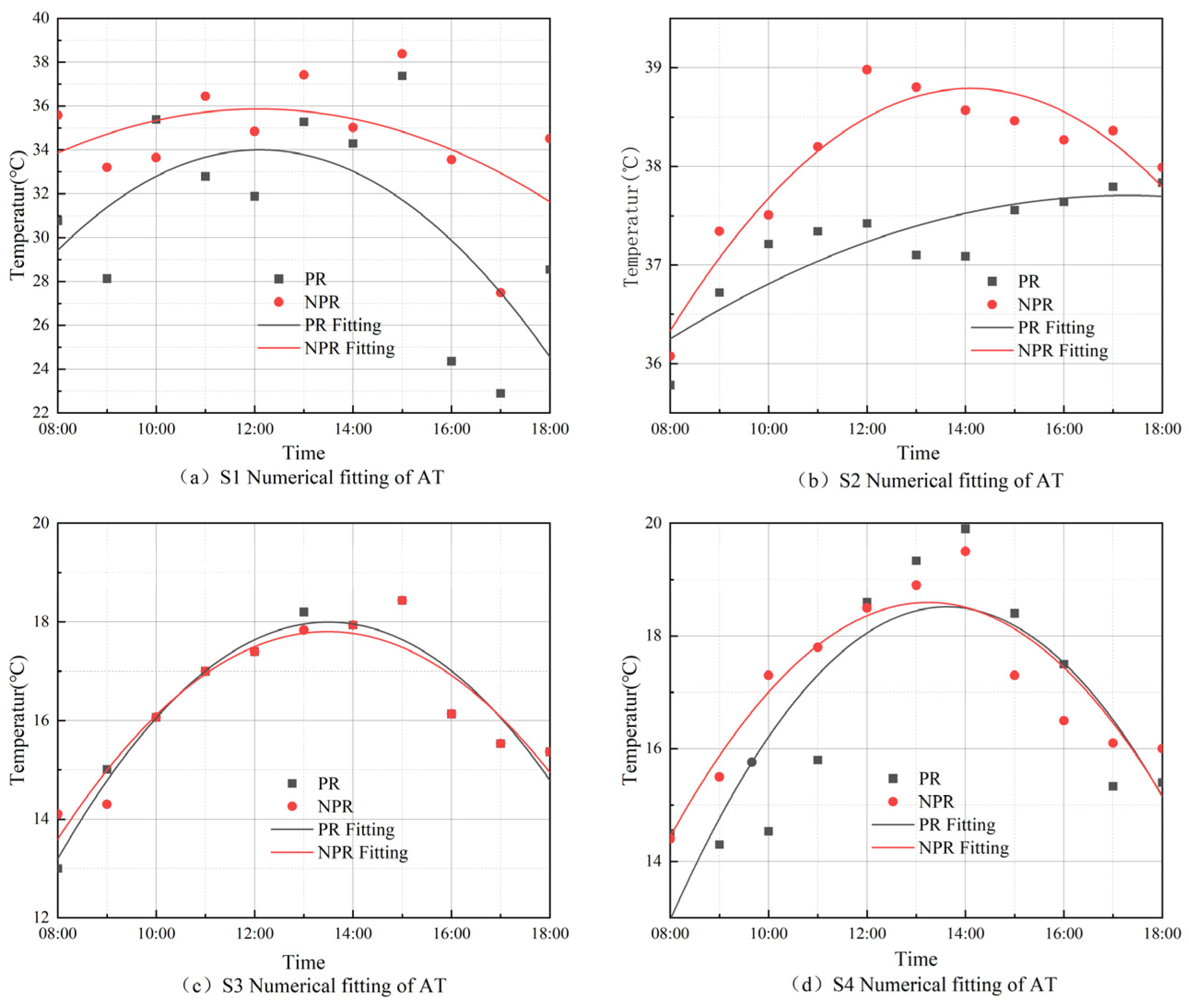
| Point Number | Rooms | Location | Test Content | Equipment | Range | Accuracy | Time/min |
|---|---|---|---|---|---|---|---|
| N1 | PR | 1.5 m from the external window at a height of 1.0 m | Air temperature Relative humidity Wind speed | DT-8892 temperature and humidity tester | T: −30.0~100 °C RH: 0~100% | ±0.1 °C ±3% | 15 |
| N2 | NPR | ||||||
| M1 | PR | 3 m from the external window at a height of 1.0 m | |||||
| M2 | NPR | ||||||
| F1 | PR | 4.5 m from the external window at a height of 1.0 m | TES-1340 handheld anemometer | W: 0~30.0 m/s | ±3% | ||
| F2 | NPR | ||||||
| P1 | PR | Cavity | |||||
| R1 | PR | Wall, ceiling, and window center | Surface center temperature | Four-wire pt100 temperature sensor | T: −50.0~100 °C | ±0.1 °C | 15 |
| L1 | |||||||
| C1 | |||||||
| W1 | |||||||
| W3 | |||||||
| R2 | NPR | ||||||
| L2 | |||||||
| C2 | |||||||
| W2 |
| Scenario | IET (°C) | WST (°C) | RH (%) | IWS (m/s) | |||||||
|---|---|---|---|---|---|---|---|---|---|---|---|
| Avg | Max | Min | Avg | Max | Min | Avg | Max | Avg | Max | ||
| S1 | PR | 33.9 | 35.9 | 32.1 | 34.3 | 36.4 | 31.9 | 60.3 | 66.9 | 0.7 | 2.8 |
| NPR | 34.7 | 36.8 | 32.8 | 34.9 | 37.4 | 32.6 | 57.9 | 63.3 | 0.3 | 1.4 | |
| S2 | PR | 34.5 | 35.6 | 33.2 | 36.0 | 37.3 | 33.2 | 57.6 | 61.7 | - | - |
| NPR | 35.3 | 36.8 | 33.7 | 36.2 | 38.1 | 33.0 | 54.5 | 59.3 | - | - | |
| Scenario | IET (°C) | WST (°C) | RH (%) | ||||||
|---|---|---|---|---|---|---|---|---|---|
| Avg | Max | Min | Avg | Max | Min | Avg | Max | ||
| S3 | PR | 16.3 | 18.7 | 12.8 | 18.0 | 21.5 | 13.8 | 41.7 | 52.2 |
| NPR | 18.1 | 20.9 | 12.8 | 18.1 | 22.5 | 13.6 | 46.0 | 56.1 | |
| S4 | PR | 17.0 | 21.1 | 14.3 | 17.1 | 20.6 | 13.6 | 39.2 | 44.5 |
| NPR | 17.2 | 21.5 | 14.1 | 17.2 | 22.3 | 13.0 | 47.5 | 51.5 | |
| Scenario | Left Wall (°C) | Right Wall (°C) | Ceiling (°C) | |
|---|---|---|---|---|
| S3 | PR | 17.9 | 17.8 | 17.7 |
| NPR | 17.8 | 17.7 | 17.6 | |
| S4 | PR | 15.4 | 15.7 | 13.8 |
| NPR | 14.7 | 14.7 | 13.6 | |
| Scenario | PR | NPR | ||||
|---|---|---|---|---|---|---|
| Avg (°C) | Max (°C) | Min (°C) | Avg (°C) | Max (°C) | Min (°C) | |
| S1 | 31.1 | 37.4 | 22.9 | 34.6 | 38.4 | 27.5 |
| S2 | 37.3 | 37.9 | 35.8 | 38.1 | 39.0 | 36.1 |
| S3 | 16.4 | 18.7 | 13.0 | 16.5 | 18.7 | 14.1 |
| S4 | 16.7 | 19.9 | 14.3 | 17.2 | 19.5 | 14.4 |
| AT (°C) | Thermal Perception |
|---|---|
| <4 | Very cold |
| 4~8 | Cold |
| 8~13 | Cool |
| 13~18 | Slightly cool |
| 18~23 | Comfortable |
| 23~29 | Slightly warm |
| 29~35 | Warm |
| 35~41 | Hot |
| >41 | Very hot |
| Project | S1 | S2 | S3 | S4 |
|---|---|---|---|---|
| A | 13.930 ± 3.057 | 29.794 ± 1.814 | −13.961 ± 3.371 | −17.267 ± 9.313 |
| B | 75.033 ± 11.745 | 14.778 ± 6.972 | 111.098 ± 12.952 | 126.155 ± 35.785 |
| C | −66.260 ± 10.779 | −9.533 ± 6.400 | −96.269 ± 11.886 | −109.583 ± 32.844 |
| RRS | 0.301 | 0.106 | 0.365 | 2.790 |
| R2 | 0.848 | 0.826 | 0.918 | 0.651 |
| Project | S1 | S2 | S3 | S4 |
|---|---|---|---|---|
| A | 20.611 ± 3.989 | 22.577 ± 1.599 | −23.879 ± 3.374 | −11.928 ± 6.783 |
| B | 56.269 ± 15.327 | 47.534 ± 6.144 | 156.633 ± 12.966 | 112.749 ± 26.066 |
| C | −52.565 ± 14.067 | −40.011 ± 5.639 | −137.958 ± 11.900 | −102.646 ± 23.924 |
| RRS | 0.512 | 0.082 | 0.366 | 1.480 |
| R2 | 0.639 | 0.919 | 0.953 | 0.701 |
| Scenario | Sources of Variance | PR | NPR | ||||
|---|---|---|---|---|---|---|---|
| SS | MS | F | SS | MS | F | ||
| S1 | Regression | 13.372 | 6.686 | 22.249 | 7.233 | 3.616 | 7.066 |
| Residual | 2.404 | 3.001 | - | 4.094 | 0.512 | - | |
| S2 | Regression | 4.018 | 2.009 | 18.973 | 7.491 | 3.746 | 45.556 |
| Residual | 0.847 | 0.105 | - | 0.658 | 0.082 | - | |
| S3 | Regression | 32.816 | 16.408 | 44.897 | 59.059 | 29.529 | 80.638 |
| Residual | 2.924 | 0.365 | - | 2.930 | 0.366 | - | |
| S4 | Regression | 41.626 | 20.812 | 7.461 | 27.706 | 13.853 | 9.359 |
| Residual | 22.317 | 2.790 | - | 11.841 | 1.480 | - | |
| Project | S1 | S2 | S3 | S4 |
|---|---|---|---|---|
| A | 12.521 ± 4.142 | 16.965 ± 1.200 | −22.278 ± 8.471 | −23.004 ± 6.384 |
| B | 85.280 ± 15.718 | 66.778 ± 4.611 | 160.691 ± 32.551 | 152.392 ± 24.530 |
| C | −78.679 ± 14.610 | −55.317 ± 4.232 | −152.056 ± 29.875 | −137.891 ± 22.513 |
| RRS | 0.552 | 0.027 | 2.308 | 1.310 |
| R2 | 0.784 | 0.984 | 0.773 | 0.829 |
| Project | S1 | S2 | S3 | S4 |
|---|---|---|---|---|
| A | 7.831 ± 3.630 | 11.757 ± 3.137 | −18.261 ± 11.570 | −20.873 ± 11.302 |
| B | 105.323 ± 13.948 | 85.338 ± 12.052 | 136.945 ± 44.455 | 150.487 ± 43.429 |
| C | −96.537 ± 12.801 | −70.355 ± 11.062 | −121.779 ± 40.801 | −141.247 ± 39.859 |
| RRS | 0.424 | 0.200 | 4.305 | 4.108 |
| R2 | 0.877 | 0.937 | 0.556 | 0.616 |
| Scenario | Sources of Variance | PR | NPR | ||||
|---|---|---|---|---|---|---|---|
| SS | MS | F | SS | MS | F | ||
| S1 | Regression | 16.010 | 8.005 | 14.502 | 24.206 | 12.103 | 28.557 |
| Residual | 4.416 | 0.552 | - | 3.391 | 0.424 | - | |
| S2 | Regression | 16.877 | 8.438 | 182.192 | 28.685 | 14.342 | 45.322 |
| Residual | 0.371 | 0.046 | - | 2.532 | 0.316 | - | |
| S3 | Regression | 62.904 | 31.452 | 13.627 | 43.161 | 21.581 | 5.013 |
| Residual | 18.465 | 2.308 | - | 34.441 | 4.305 | - | |
| S4 | Regression | 50.903 | 25.451 | 19.417 | 52.818 | 26.409 | 6.428 |
| Residual | 10.486 | 1.312 | - | 32.869 | 4.109 | - | |
| Project | S1 | S2 | S3 | S4 |
|---|---|---|---|---|
| A | −5.851 ± 22.287 | 32.655 ± 1.814 | −10.914 ± 2.928 | −14.089 ± 6.895 |
| B | 158.026 ± 85.635 | 14.027 ± 6.969 | 102.773 ± 11.251 | 114.892 ± 26.493 |
| C | −156.657 ± 78.595 | −9.738 ± 6.396 | −91.336 ± 10.326 | −101.214 ± 24.316 |
| RRS | 0.907 | 0.131 | 0.286 | 1.546 |
| R2 | 0.763 | 0.711 | 0913 | 0.719 |
| Project | S1 | S2 | S3 | S4 |
|---|---|---|---|---|
| A | 18.255 ± 15.731 | 25.678 ± 1.618 | −7.647 ± 3.277 | −7.927 ± 3.804 |
| B | 69.979 ± 60.444 | 44.608 ± 6.215 | 90.613 ± 12.591 | 96.145 ± 14.617 |
| C | −69.518 ± 55.475 | −37.944 ± 5.704 | −80.649 ± 11.557 | −87.138 ± 13.416 |
| RRS | 1.020 | 0.146 | 0.350 | 0.465 |
| R2 | 0.617 | 0.846 | 0.868 | 0.844 |
| Scenario | Sources of Variance | PR | NPR | ||||
|---|---|---|---|---|---|---|---|
| SS | MS | F | SS | MS | F | ||
| S1 | Regression | 89.547 | 44.774 | 2.803 | 17.928 | 8.964 | 1.126 |
| Residual | 127.799 | 15.975 | - | 63.669 | 7.959 | - | |
| S2 | Regression | 2.555 | 1.277 | 12.074 | 6.066 | 3.032 | 36.040 |
| Residual | 0.846 | 0.106 | - | 0.673 | 0.084 | - | |
| S3 | Regression | 24.369 | 12.184 | 44.187 | 18.830 | 9.415 | 27.259 |
| Residual | 2.206 | 0.276 | - | 2.763 | 0.345 | - | |
| S4 | Regression | 31.743 | 15.871 | 10.380 | 20.218 | 10.109 | 21.719 |
| Residual | 12.232 | 1.529 | - | 3.724 | 0.465 | - | |
Disclaimer/Publisher’s Note: The statements, opinions and data contained in all publications are solely those of the individual author(s) and contributor(s) and not of MDPI and/or the editor(s). MDPI and/or the editor(s) disclaim responsibility for any injury to people or property resulting from any ideas, methods, instructions or products referred to in the content. |
© 2023 by the authors. Licensee MDPI, Basel, Switzerland. This article is an open access article distributed under the terms and conditions of the Creative Commons Attribution (CC BY) license (https://creativecommons.org/licenses/by/4.0/).
Share and Cite
Yu, H.; Zhang, H.; Han, X.; Gao, N.; Ke, Z.; Yan, J. An Empirical Study of a Passive Exterior Window for an Office Building in the Context of Ultra-Low Energy. Sustainability 2023, 15, 13210. https://doi.org/10.3390/su151713210
Yu H, Zhang H, Han X, Gao N, Ke Z, Yan J. An Empirical Study of a Passive Exterior Window for an Office Building in the Context of Ultra-Low Energy. Sustainability. 2023; 15(17):13210. https://doi.org/10.3390/su151713210
Chicago/Turabian StyleYu, Haibo, Hui Zhang, Xiaolin Han, Ningcheng Gao, Zikang Ke, and Junle Yan. 2023. "An Empirical Study of a Passive Exterior Window for an Office Building in the Context of Ultra-Low Energy" Sustainability 15, no. 17: 13210. https://doi.org/10.3390/su151713210
APA StyleYu, H., Zhang, H., Han, X., Gao, N., Ke, Z., & Yan, J. (2023). An Empirical Study of a Passive Exterior Window for an Office Building in the Context of Ultra-Low Energy. Sustainability, 15(17), 13210. https://doi.org/10.3390/su151713210





